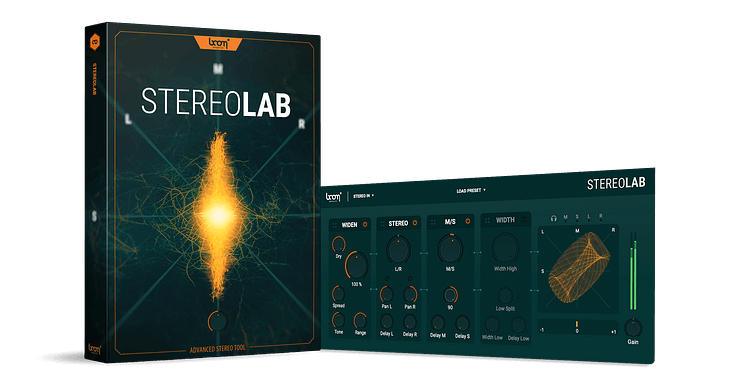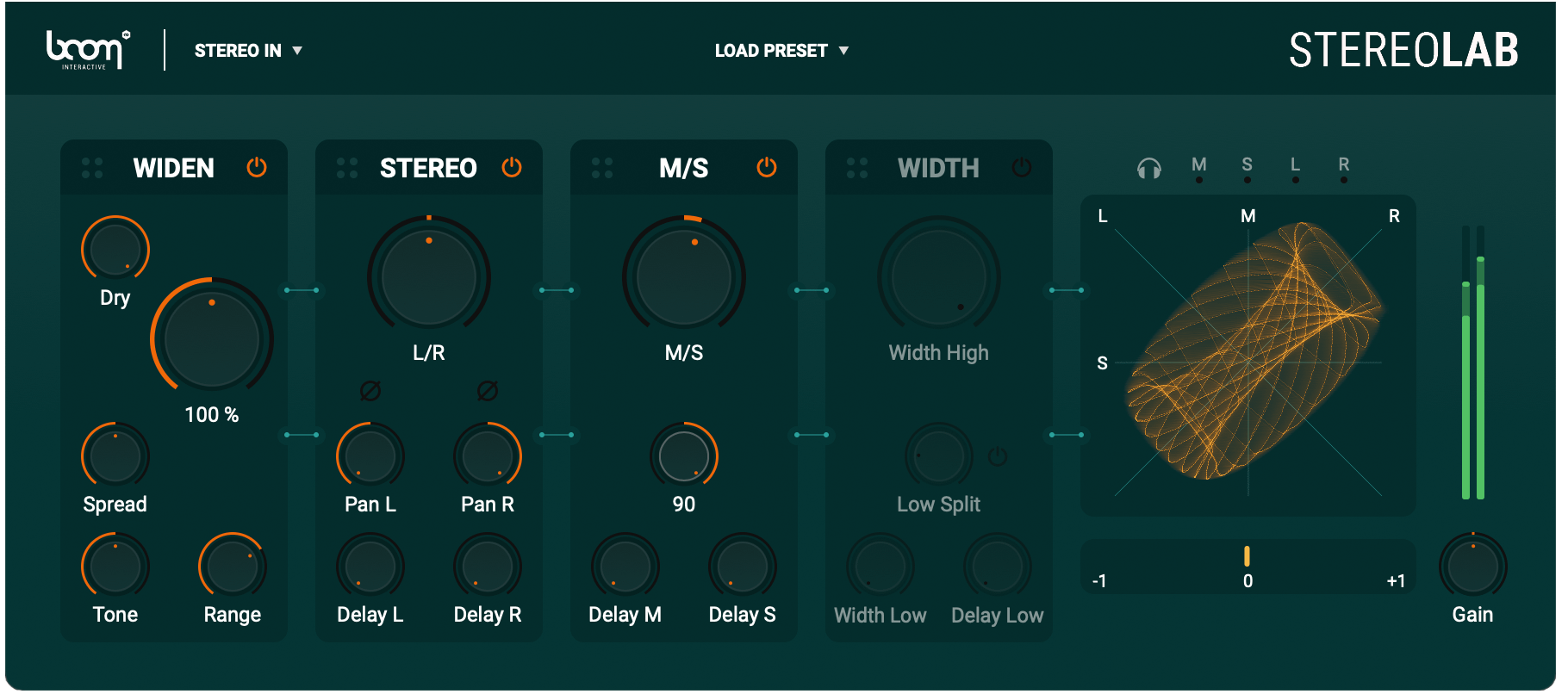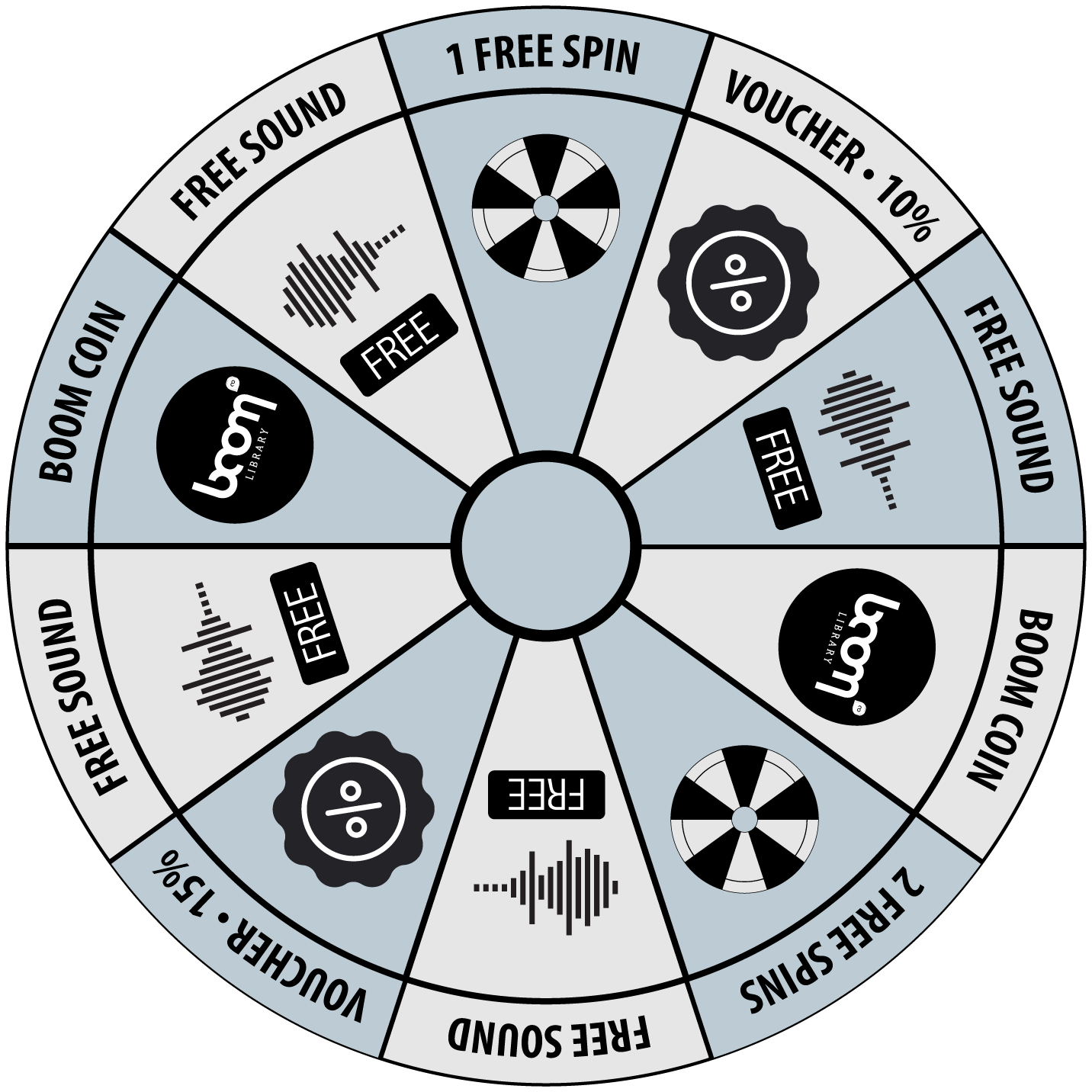
STEREOLAB
Bring balance to your audio
Tired of dealing with a mess of plug-ins to resolve your stereo issues? With STEREOLAB, effortlessly sculpt and shape the stereo image of your audio signals with precision and ease – and do it all with a single plug-in. This all-in-one stereo-mono plug-in will become a necessity in all your FX chains, as it really helps solve your stereo issues and modify your imaging in both standard and creative ways. It’s a simple-to-use solution that makes it easy to carve out the right audio position for your tracks with surgical precision.
With STEREOLAB, you can easily morph your mono signal into a full-range stereo sound or shrink your wide field into a coherent, single mono mix to ensure that it’s always theatre, club, and radio ready. You can use it for vocal and instrument widening, gun tails and explosions, and tons more. The left/right independent panning, Mid/Side gain, and precision delays for interaural time differences make it a true stereophonic beast that you’ll come to rely on time and again.
We sat down with the lead developer, Jan Obergfell-Bourmer to give us his insights on this surprisingly versatile plug-in.
The Trailer
TAKE CONTROL OF YOUR STEREO
“I thought it was a good idea to have this combination of tools in one product, mostly for convenience,” Jan shares.
Most DAWs have some of these tools in various plug-ins, and some you’d have to buy third party depending on which DAW you use. What’s always been lacking though is an easy tool that brings them all together, allowing you to easily change up the chain and measure the effects. That’s exactly what STEREOLAB does.
“In the typical DAW setup, you’ll have some or all the tools cluttered over different places. It’s really about having one convenient thing that reduces your cognitive load when working on something.”

MODULAR MAGIC
The basic set up of the plug-in was made with ease-of-use in mind. There are four sound modules, WIDEN, WIDTH, M/S, STEREO, each featuring their own set of tweaking options and can be re-arranged as you like to either improve or experiment with your sound. “The UI is animated very fluidly,” Jan says. “It’s very responsive and interactive, and you can see exactly what’s going on. It starts up in INIT, so it doesn’t do anything to the sound to alter it when it starts up.”
Browsing through the presets, you can find how the modules are arranged to create different outcomes. They can combine them in any order and enable and disable them as well. For example, if you put WIDTH after WIDEN in the chain, you’ll greatly limit your use of WIDEN, though you can let some of the effect bleed through using the bypass options.
Most presets are for traditional outcomes, but you can experiment with them and come up with a lot of interesting and crazy effects, from creating dopplers to making things immersive or ultra-wide or shimmering with movement. All options are automatable as well, so you can use your DAW to modulate the parameters for different results.
WIDEN
We’ll start with WIDEN since it’s Jan’s favorite. WIDEN allows you to take a mono signal and create a wider soundscape that wasn’t there before. Just how massive you want it is up to you by tweaking the available knobs. “I like to widen stuff,” Jan shares. “I think it’s one of the best features because it’s so versatile. I just enable it and can pull it up and adjust it exactly to my liking.”
WIDTH
WIDTH serves as the exact opposite to WIDEN. It takes the existing signal and can add nothing to it. But it can shrink the stereo field until it’s entirely mono. These modules work incredibly on things like bass, where you’d want to let the upper frequency range shine but narrow down the low frequencies towards the center. “With the optional band splitter, it can be used to selectively control low-frequency width,” Jan explains.
M/S
The M/S module allows you to gain more control over either the mid or side elements of the stereo field. “It’s helpful to add movement with the special rotation feature,” Jan explains.
STEREO
The STEREO module gives you extended panning and stereo options. “It’s like an independent 2-channel mixer, where you get precise control,” Jan says. The STEREO module allows for some interesting purposes. “We introduced these delays to create the possibility of using inter-aural time differences to make a signal sound like it’s coming from the left or right without making the channels louder or quieter. It works great on drums.”
VECTORSCOPE
And at the end of the effects chain, STEREOLAB includes a vectorscope so that you have clear, visual feedback on what’s happening to your sound. “The vector scope provides an immediate representation of how wide your signal is and whether it leans more towards the left or right,” Jan explained. “It’s pretty intuitive to understand what’s going on.”
Underneath the vectorscope is another useful meter to have. This one checks for mono-compatibility. On the -1 side, it means it’s not at all compatible and the stereo signals are canceling each other out. 0 means you have a nice and rich stereo field. +1 means that the sounds on the right and the left are all the same. With most mixing cases, you want to be mostly 0 to +1.

USING STEREOLAB
What are some major uses that STEREOLAB will handle in your future chains? What are some basic tips to get your sound under control?
MONO COMPATIBILITY
This is, of course, a constant need for producers to understand. You want to make sure your music sounds good in the club, for example, a setting which nearly always sums everything to mono. STEREOLAB makes it super easy to check for this. Just by clicking on the “M” button above you can see what mono signal is coming through. Additionally, the meter below it allows you to see if the signal is mono incompatible (the more to the -1 it goes). Jan walks us through one scenario:
“If I just reduce the width (using WIDTH), I have the problem that I’m losing information, it’s getting quieter. So what else can I do? I could select only the left channel. If I only use the left channel and turn it into mono and discard the right channel, I can artificially WIDEN the signal again to end up with something that sounds stereo, but still the original stereo information is lost. So let’s not do that. Let’s just go back to default. What I can now try is to adjust the balance between the mid and side signal (using M/S) to get it narrower. This narrows the stereo image and makes it a little louder. So that’s already much better. We still have a bit of the original stereo information left, and we’re in the safe zone. And you can see the left channel is a little louder, so I just rotated it a tiny bit with the knob on M/S until it looks good. And yeah, there I repaired it.”
INTER-AURAL TIME DIFFERENCES
Our ability to perceive sound localization and spatial cues is aided by interaural time delay, which is the difference in time between when a sound reaches each ear. By analyzing these timing differences, the brain can accurately determine the direction of sound sources. This crucial ability allows us to better understand our acoustic environment and appreciate the richness and complexity of the sounds around us. “The STEREO module as very precise delays in the sub-millisecond range and decent quality interpolation, which is nice to have,” Jan says. “Here’s an example of how it works with drums. Load some in. Once you dial in just a tiny bit of delay for the left channel, the signal sounds like it’s coming from the right because the left is coming just a little bit later. You can really hear it on a snare. It’s a useful tool for creating a sense of space and depth in a mix without changing the overall volume of the channels.
“Human hearing is very sensitive to ultra-short delays when localizing sound. It’s an interesting alternative to regular panning and can create cool effects. The M/S tool has delays on the mid and side channels, which is unusual. I don’t think any other plugin offers this right out of the box. By delaying the side channel, you can create a sense of roominess that wasn’t there before, especially if the side channel carries mostly reverb information. There are opportunities for more creative effects by combining these modules and experimenting with different delay settings.”
SOUND ROTATION
STEREOLAB of course includes traditional panning, but it goes a step further with the M/S module’s rotation tool. “With panning you have the problem that once the signal is completely moved to the right channel, there is no stereo information left because only one channel is playing,” Jan explains. “You don’t have this problem when using the rotation tool instead, as all the information stays there. You have to be careful, of course, because once you rotate it too far, you end up with a signal where the left and right channels cancel each other out when summed to mono.”
SEIZE THE STEREO
So what are you waiting for? Take control of your stereo field with STEREOLAB and bring balance to your music. With very simple controls, this plug-in makes it easy to carve out the right audio position for your tracks. Try it out today and hear the difference for yourself.
Click here to learn more about our new plug-in.
Make sure to order STEREOLAB by August 15 to save 20% with our introductory offer!
DEMOS
COLORING EXPLOSION TAIL
Use micro delays to create inter-aural differences to create sound source placement.
BACKING VOCAL WIDENING
Add massive depth to vocals by spreading the signal ultra-wide.
ACOUSTIC GUITAR SPREAD
Create a sense of live ambience using spread on your guitar rhythms.
CLEAN AND REARRANGE STEREO IMAGE
Bring sounds to life with clear movement and direction.
CREATE ROOM IN CENTER
Immerse your audience in the ambiance of a scene while keeping what’s important front and center.
MONO AMBIENCE TO STEREO
Widen mono ambient recordings to give them more space and present.
MONO VOICE TO STEREO
Aid your mix by bringing your mono voice into stereo.
WEIRD IMAGE ICECRACK
Get creative with stereo effects and mangle in ways you never thought possible.












































































































































































































































